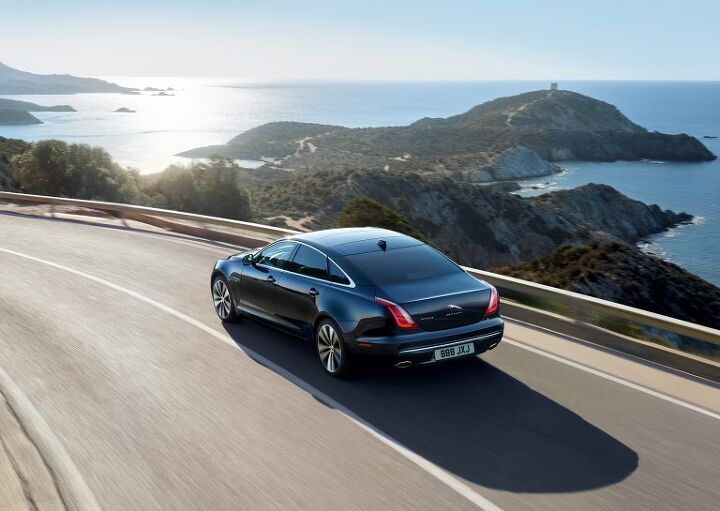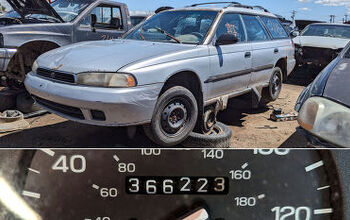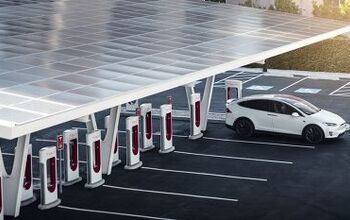Jaguar to End XJ Production; Company Promises a Resurrection

Once the sedan of choice for discerning Anglophiles and 1980s crime-fighting New Yorkers played by Edward Woodward, Jaguar’s XJ has seen a long fall from grace. This summer, the stately model officially hits the ground.
Amid tanking sales for both it and its sedan stablemates, the Jaguar XJ will cease production in a matter of months, with the automaker claiming its death is merely a passing phase.
Confirmed by a Jaguar spokesperson via Jalopnik, the end of the XJ’s 51-year production run this summer paves the way for the future introduction of a different take on British luxury motoring.
In a statement, the spokesperson said Jaguar will “continue the XJ nameplate and will use its renowned engineering capability and technological innovation to ensure its longevity.”
If you’re thinking all of those Autocar reports were right, you’re probably correct. The British publication has long forecasted the impending death of the XJ and its rebirth as an electric vehicle, possibly one containing a hatchback. Design boss Ian Callum and his team are reportedly working on something that bears no similarities to the XJs of old.
Which is too bad, as the pre-2004, steel-bodied XJs are gorgeous creatures you probably don’t want to own — and certainly don’t want to work on. Updating your image, however, requires a change of clothes. The automaker has already made waves in the emerging green vehicle market with its I-Pace SUV, and an all-electric XJ fastback five-door would need to leave the past in the rear-view to tempt the younger, forward-thinking set that will supposedly buy this vehicle.
Europe’s newfound disdain for internal combustion vehicles has made going electric (or partially electric) essential to the survival of many models. Thankfully, Jag has the platform and related tech to swap the XJ into a new persona. It’s probably best to get the transition out of the way before Mercedes-Benz, BMW, and Audi go the same route.
With the model ending production at the UK’s Castle Bromwich plant this year, a successor can’t be too far away.
The XJ peaked in the U.S. in 1986 (the year after The Equalizer first aired), selling over 19,000 units that year, only to see its fortunes fall in the following decades. The last time U.S. buyers took home more than 10,000 XJs in one year was 2004. Last year’s sales tally amounted to just 1,579 vehicles, the worst showing since the recession year of 2009, with some months returning double-digit sales.
In April, 93 American nonconformists drove away in a new XJ.
[Images: Jaguar Land Rover, Murilee Martin/TTAC]

More by Steph Willems
Latest Car Reviews
Read moreLatest Product Reviews
Read moreRecent Comments
- Mike-NB2 This is a mostly uninformed vote, but I'll go with the Mazda 3 too.I haven't driven a new Civic, so I can't say anything about it, but two weeks ago I had a 2023 Corolla as a rental. While I can understand why so many people buy these, I was surprised at how bad the CVT is. Many rentals I've driven have a CVT and while I know it has one and can tell, they aren't usually too bad. I'd never own a car with a CVT, but I can live with one as a rental. But the Corolla's CVT was terrible. It was like it screamed "CVT!" the whole time. On the highway with cruise control on, I could feel it adjusting to track the set speed. Passing on the highway (two-lane) was risky. The engine isn't under-powered, but the CVT makes it seem that way.A minor complaint is about the steering. It's waaaay over-assisted. At low speeds, it's like a 70s LTD with one-finger effort. Maybe that's deliberate though, given the Corolla's demographic.
- Mike-NB2 2019 Ranger - 30,000 miles / 50,000 km. Nothing but oil changes. Original tires are being replaced a week from Wednesday. (Not all that mileage is on the original A/S tires. I put dedicated winter rims/tires on it every winter.)2024 - Golf R - 1700 miles / 2800 km. Not really broken in yet. Nothing but gas in the tank.
- SaulTigh I've got a 2014 F150 with 87K on the clock and have spent exactly $4,180.77 in maintenance and repairs in that time. That's pretty hard to beat.Hard to say on my 2019 Mercedes, because I prepaid for three years of service (B,A,B) and am getting the last of those at the end of the month. Did just drop $1,700 on new Michelins for it at Tire Rack. Tires for the F150 late last year were under $700, so I'd say the Benz is roughly 2 to 3 times as pricy for anything over the Ford.I have the F150 serviced at a large independent shop, the Benz at the dealership.
- Bike Rather have a union negotiating my pay rises with inflation at the moment.
- Bike Poor Redapple won't be sitting down for a while after opening that can of Whiparse




































Comments
Join the conversation
Electric Jag? I guess they'll call it the e-Type.
Chances are, the XJ will be brought back as a Navigator-sized 3 row crossover with a giant cat on the hood that does double duty as a forward collision sensor.